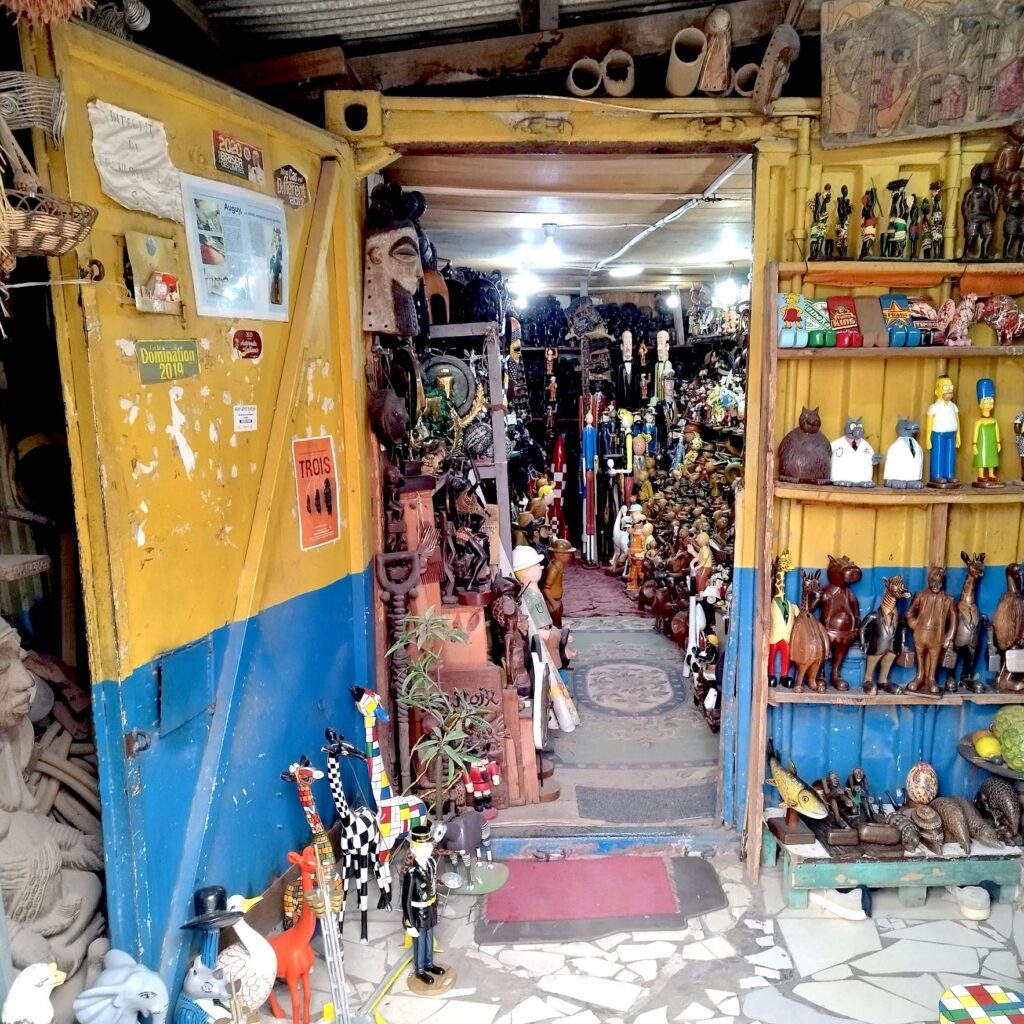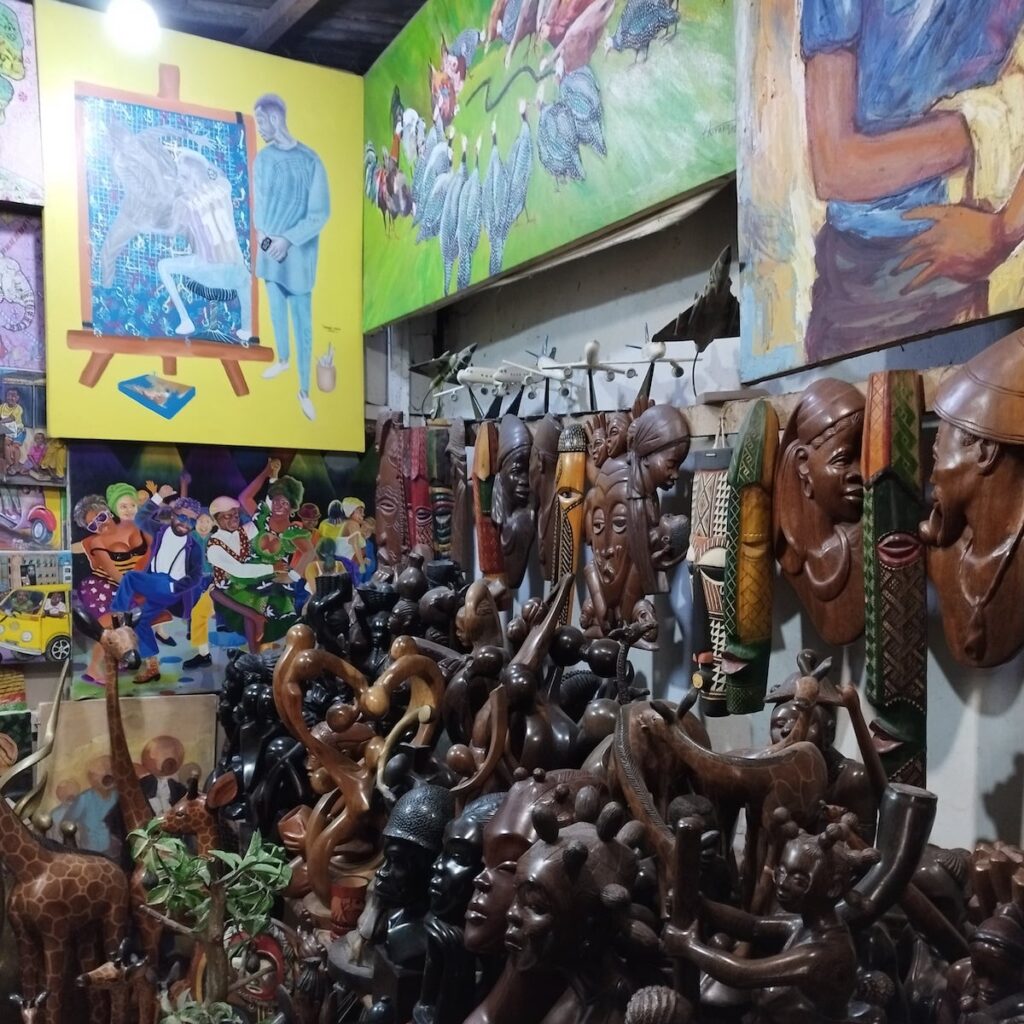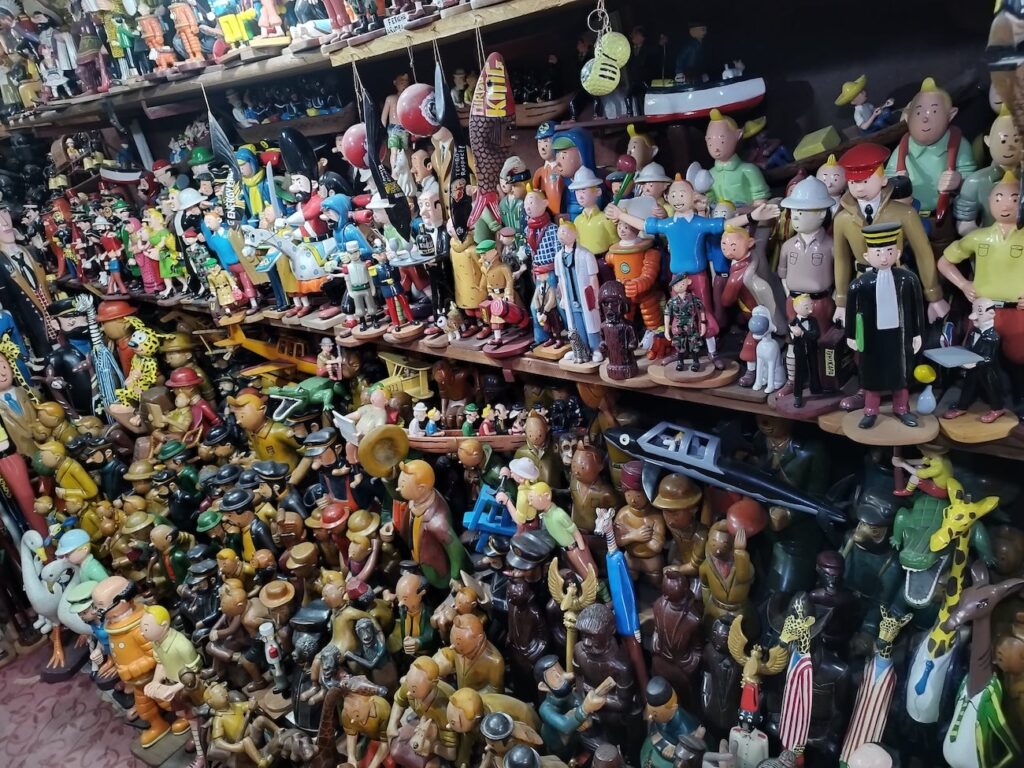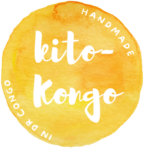Introduction
In the vibrant city of Kinshasa, artisans and art dealers bring the bustling streets to life with their unique crafts. Especially in neighborhoods favored by expats and tourists, one thing stands out – captivating Tintin figurines and statues. These charming pieces are reminiscent of a beloved comic series, connecting generations with their nostalgia. They’re the perfect piece to fall in love with, to gift to someone special, or to keep as a cherished memento.. These figures form the cornerstone of my introduction to Auguy Kakese – a skilled sculptor, a zealous mentor, and an ardent preserver of Congolese culture.
However, this tale extends beyond Tintin. It’s a journey into the heart of Congo’s art scene, tracing Auguy’s life as an artist and mentor. It’s about the preservation of history and culture, the challenges of an artist’s life, and the sparks that kindle the creative spirit. So, let’s leave the familiarity of Tintin behind for a moment, and delve into an enriching conversation that unveils the tapestry of Auguy’s artistry.
Early Years and Artistic Struggles
Kitokongo: Hello Auguy. It’s great to be back here in your showroom and atelier.
Auguy: Hello, kitokongo. It’s nice to see you again. Welcome back!

Kitokongo: Stepping into your atelier, one can’t help but feel immersed in a world of creativity. Surrounded by such an array of sculptures and paintings is truly a treat. Can you give us a glimpse into your early years as an artist and how you ventured into this career?
Auguy: My love for art took root at a very tender age, growing over the years as I diligently honed my craft. The journey wasn’t a walk in the park. My father, in particular, was my biggest critic, not appreciating my passion and often trying to dissuade me. But art was, and still is, more than just a hobby for me; it’s a part of me, ingrained in my very being. And so, I refused to back down. At the age of 15, I decided to devote myself entirely to the art of sculpting, with Master Kwete becoming my first and longest-serving mentor.
My love for art took root at a very tender age (…) it’s a part of me, ingrained in my very being.
Kitokongo: In the current times, what is it like being both a sculptor and a mentor?
Auguy: The advent of the coronavirus has significantly amplified the challenges we face as artists. The financial strain is more intense than ever with a noticeable reduction in customers. The galleries and venues that once showcased our work have all but disappeared. That’s why you see so many pieces here in my workshop, awaiting buyers.
But then, should I cease mentoring the upcoming generation who are keen to learn from me?
Another growing concern is the dwindling interest among young people to pursue art, especially given the lack of customers. This lack of interest is particularly noticeable when it comes to sculpting as more and more young artists gravitate towards painting. It’s disheartening to think that with time, the art of sculpting might lose its torchbearers.
Yet, despite these adversities, we persist. We continue to work, always clinging to the hope that the tides will turn.
Another growing concern is the dwindling interest among young people to pursue art, especially given the lack of customers. This lack of interest is particularly noticeable when it comes to sculpting (…).
The Tradition of Mentorship in Congo
Kitokongo: Each statue here is a compelling testament to Congo’s vibrant cultural heritage. Can you share with us how you acquired this knowledge?

Auguy: These sculptures, steeped in Kuba art, particularly reflect the Kasai style of the Kuba tradition. This was the torch that was passed to me, igniting my creative journey. My mentors, Papa Kwete and Papa Faustin, entrusted me with this age-old sculpting tradition. My time at the Académie des Beaux-Arts, working alongside Professor Vah, enriched my understanding further. My experience is not limited to Congolese masters; I’ve also had the privilege to work with French, Belgian, and other international artists.
Under the guidance of Papa Lufwa, I ventured into creating my unique Kolon statues, which, unlike traditional ones, are adorned with clothes and huts.
Now, it feels like my responsibility to carry forward this artistic heritage. While it evolves with each generation, it’s crucial to preserve it for our youth. Many artists have emerged from my workshop, some gaining international acclaim and starting their own ateliers. However, it’s disheartening to see the decreasing number of students over time.
Kitokongo: This mentor-mentee tradition seems quite prominent among Congolese artists. Every artist I’ve met has learnt under a Master or an established artist who selflessly guided them. Could you shed some light on why this is so prevalent in Congo?

After all, no one is born an artist. Some people are born with innate talent while others are driven by the desire to learn. However, both have to work towards becoming an artist, nurturing their skills, honing their craft, and persisting through the challenges that come their way.
Auguy: Well, in my view, those who don’t share their knowledge are selfish, and those who share it at a cost are greedy. As Congolese, we are neither. Our culture promotes the transmission and sharing of knowledge. Anyone with the capability to mentor should willingly do so. It’s about preserving our future, ensuring that our cultural and artistic heritage doesn’t fade into oblivion. This sentiment drives my mentorship, and it’s also my way of paying homage to my mentors.
Selecting the right students? Often, it’s those who display an intense desire to learn. They stand out, their enthusiasm apparent. Recognizing this passion, you know you can nurture them. Then, there are those who might lack this keenness but possess innate talent. To them, you can extend the offer of mentorship, while keeping an eye on how their passion evolves over time. After all, no one is born an artist. Some people are born with innate talent while others are driven by the desire to learn. However, both have to work towards becoming an artist, nurturing their skills, honing their craft, and persisting through the challenges that come their way.
Building an Artisanal Sanctuary Despite Difficulties
Kitokongo: Could you share the story of how you built this atelier, which is not just an atelier but also a workshop and a showroom?
Auguy: I initially worked with my mentor, Master Faustin Keké. However, he relocated from Kinshasa to Brazzaville, leaving me alone without resources or financial aid. It was Master
Faustin’s friends who stepped in to help me initially. I remember one day at the French Cultural Centre, while exhibiting fruit baskets, small table trays, and similar items, I met Madame Valerie. She appreciated my talent and craftsmanship, began financing my work, and started placing orders. Her guidance was invaluable. After a decade at the French Cultural Centre, I decided to branch out and establish my workshop.
Before the lockdown, there were 16 students under my tutelage in this workshop. The coronavirus-induced lockdown brought difficult times for all, especially for us artists in Kinshasa. The expatriate community had left, tourism came to a halt, and my students were reluctant to continue their work. Thankfully, we’re slowly regaining our stride, and currently, we are a group of eight.
Kitokongo: What are the challenges you face while mentoring?
Auguy: Mentoring young people can be an uphill task. They typically shy away from tedious work and lean towards jobs that provide instant gratification. However, art demands patience. You craft a piece without knowing who might purchase it. As an artist, you produce even without specific orders. Running a workshop complicates things further. Besides teaching, you must also provide the necessary materials for learning, which can be challenging when customers are scarce. What can one do in such a scenario? That’s why our showroom is full with statues.
Running a workshop complicates things further. Besides teaching, you must also provide the necessary materials for learning, which can be challenging when customers are scarce
From Tintin Sculptures to Nurturing Young Artists
Kitokongo: I can’t help but notice your exquisite Tintin figures, arguably the best in Kinshasa. They’re so true to the comics, a testament to your sculpting mastery and attention to detail. What’s the story behind these Tintin sculptures?

In “Tintin in Congo”, Africans are portrayed carrying white characters. However, inspired by Kofi Annan’s appointment as the Secretary-General of the United Nations, I shifted my perspective. I started crafting sculptures of white characters carrying Africans, symbolizing an African’s ascent to the top, much like Kofi Annan’s journey.
Auguy: My initial artistic pursuits didn’t include Tintin sculptures. It was around the year 2000 that French and Belgian visitors here in Kinshasa inspired me to start crafting these figures. They sparked the idea that led to the creations you see today, and I’ve also passed this knowledge onto others.
An older artist named Gaston was actually the pioneer in this realm of Tintin sculptures. Unfortunately, he’s not active anymore, but it was his work that ignited our passion for this craft. Today, I can proudly say that I’ve evolved this art form in diverse ways.
In “Tintin in Congo”, Africans are portrayed carrying white characters. However, inspired by Kofi Annan’s appointment as the Secretary-General of the United Nations, I shifted my perspective. I started crafting sculptures of white characters carrying Africans, symbolizing an African’s ascent to the top, much like Kofi Annan’s journey.
Kitokongo: For young artists just starting out who are hesitating about their direction – painting, sculpture or other art forms – what advice can you share?
Auguy: Art is a gift that resides within. To our youth, especially Congolese youth, I say, “Don’t rush.” Nowadays, fewer individuals choose to pursue sculpting as it’s considered laborious.
Many prefer painting as it’s quicker and easier to master. However, I encourage our youth to venture into sculpture, visit workshops, learn, and give this art form a fair chance. Don’t opt for the easy route right away. The sculpture we teach is part of our culture and it shouldn’t be forgotten.
To all aspiring artists, don’t rush your journey. Don’t start creating with an expectation to sell your work for exorbitant prices. Start small, be patient, and evolve. Accept criticism, because that’s how you progress.
Take my students, for example. Their growth and improvement are a result of the advice and guidance I’ve provided. And to conclude, I say, “Be patient, absorb, learn, and march forward.”
Kitokongo: Thank you, Auguy, for this enriching conversation. I hope many young artists find inspiration and guidance from your words.

To all aspiring artists, don’t rush your journey. Don’t start creating with an expectation to sell your work for exorbitant prices. Start small, be patient, and evolve. Accept criticism, because that’s how you progress.
Conclusion
From his early years in art to his steadfast determination to preserve Congolese culture through sculpting, Auguy’s journey serves as a testament to the transformative power of passion and perseverance. Despite the myriad of challenges he faces as an artist and a mentor, he remains deeply committed to his craft, eagerly passing on his knowledge to the next generation. His mastery of Tintin figures is undeniable, yet his aspiration to maintain Congo’s cultural heritage through the art of sculpture sets him apart.
Through his profound insights and inspiring words, Auguy underscores the importance of patience, learning, and resilience in the artistic journey. He encourages young artists to venture into the more laborious, less trodden path of sculpting and urges them to not lose sight of their cultural heritage.
Auguy’s story is an exemplary narration of how art can thrive even under challenging circumstances. It serves as a beacon of hope to young artists and an insightful guide for anyone seeking to understand the vibrant art scene in Congo. His commitment to mentorship and his deep-rooted passion for Congolese art are the very foundations on which the future generations will continue to build and shape the Congolese artistic landscape.
Yet, this noble task shouldn’t be carried by Auguy alone. As consumers of art, our role is integral. Each purchase, each word of encouragement, each visit to an atelier like Auguy’s, bolsters the continuity of these traditional crafts, and inspires new generations to take up the torch. So, while Auguy and his fellow mentors are doing their part, we must ask ourselves: Are we doing ours?
Note from the Author: This interview was conducted live and recorded on my smartphone amidst the hustle and bustle of daily life, without the use of a professional microphone. As such, there might be some unintentional mistakes in spelling certain names due to background noise. I want to assure you that any such errors bear no intention of disrespect. Corrections from knowledgeable readers are highly appreciated and welcomed.
